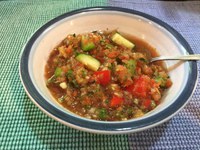Prairie Fare: Gazpacho Refreshes on a Summer Day
(Click an image below to view a high-resolution image that can be downloaded)
By Julie Garden-Robinson, Food and Nutrition Specialist
NDSU Extension Service
“We’re going to have cold soup,” I said to my older daughter and husband. We were in our kitchen talking about the upcoming evening meal.
“Gross,” my daughter remarked. She likes soup but expects it to be hot.
I gathered tomatoes, red and green peppers, celery, an onion, a lemon and a cucumber, along with two cutting boards and two knives. I began rinsing all the produce under cool water.
“I suppose we will be eating this for a week,” my husband grumbled as he noted the lineup of colorful produce on the cutting boards.
I gave both of them “the look” that only mothers and wives can deliver so compellingly.
My husband sneaked out of the kitchen. He probably thought that one of the cutting boards was earmarked for his use.
My daughter and I began to chop the fresh vegetables.
“We’re making gazpacho,” I noted to my unimpressed daughter. “This is amazingly nutritious.”
My daughter became more interested in the recipe when I pulled out the food processor and the lemon juicer. She likes kitchen gadgets. Soon our bowl of gazpacho was ready to be chilled in the refrigerator to allow the flavors to meld.
Gazpacho originated in Spain and also is eaten widely in Portugal, especially during warm summer days. You can find numerous recipes online featuring numerous TV chefs’ creations.
When I was young, no one could have gotten me to eat cold soup filled with raw tomatoes. When everyone enjoyed fresh-from-the garden tomatoes on a bacon, lettuce and tomato sandwich, or BLT, I was content with a “BL” sandwich.
When the Garden family ate sliced tomatoes sprinkled with sugar as dessert, I had no dessert.
I’m quite sure I never had fresh salsa until I went to college. I discovered that onions and peppers made the tomatoes palatable.
Tomato plants occupy a lot of space in our present-day garden. The thought of ripe tomatoes topped with fresh mozzarella, balsamic vinegar and basil leaves makes my mouth water.
Tomatoes are rich in nutrients and low in calories at just 35 calories per medium tomato. They are an excellent source of vitamins C and A. They also provide potassium, which helps maintain a healthy blood pressure.
Tomatoes are among the best sources of lycopene, which is the disease-fighting pigment responsible for tomatoes’ red color. In fact, one study showed that men who had two or more servings of tomatoes per week cut their prostate cancer risk by more than one-third.
Vine-ripened tomatoes are in season, so try some novel ways to use them on your menu or preserve them to enjoy during the long winter months.
After picking them, store them at room temperature, not in the refrigerator. If your tomatoes aren’t quite fully ripe after picking, avoid placing them in the sun because that may damage them. Fully ripe tomatoes can be stored in the refrigerator, but they will not soften further.
To skin tomatoes easily, try this method: Heat a pot of water to boiling, add the tomatoes for about 30 seconds, then plunge them into cold water. Make an “X” on the blossom end with a knife and the skin will peel easily.
See https://www.ag.ndsu.edu/food/food-preservation for a range of food preservation information available from the NDSU Extension Service website. Search for “Canning and Freezing Tomatoes and Making Salsa” for research-tested preservation instructions.
Here’s one recipe for gazpacho, but a wide range of recipes are available online. Some have added wine vinegar, Worcestershire sauce, olive oil and/or bread pieces.
You can personalize this recipe to your own taste. By the way, my daughter pronounced the soup “refreshing” and my husband said it was “not half bad.” He got to enjoy some leftovers, too.
Fresh From the Garden Gazpacho
1 1/2 c. diced tomatoes (about 2 medium)
1 medium cucumber, diced into 1/4-inch pieces
2 red bell peppers, seeded and diced into 1/4-inch pieces
1 green pepper, seeded and diced into 1/4-inch pieces
1 small jalapeno pepper, diced (optional)
2 celery stalks, diced into 1/4-inch pieces
1 lemon, juiced
1 c. low-sodium V-8 tomato juice (or similar product)
1 1/2 tsp. minced garlic
1 1/2 tsp. ground cumin
1/2 c. cilantro, chopped
Salt and pepper, to taste
Chopped cilantro (optional garnish)
Other optional add-ins, to taste (1 tsp. Worcestershire sauce, 1 tsp. balsamic vinegar)
Before preparing produce, rinse it thoroughly under cool, running water. Prepare as described and combine all ingredients except lemon juice, salt and pepper in a large bowl. Remove 2 cups of the chopped mixture and place in a second large bowl. In a food processor or blender, puree the remaining mixture and place in the second bowl. Combine all ingredients, add lemon juice and season with salt, pepper and other add-ins if desired. Refrigerate at least two hours to allow flavors to blend. Serve cold garnished with chopped cilantro.
Makes six servings, about 1 cup each. Each serving has 50 calories, 0 grams (g) fat, 2 g protein, 11 g carbohydrate, 3 g fiber and 140 milligrams sodium.
(Julie Garden-Robinson, Ph.D., R.D., L.R.D., is a North Dakota State University Extension Service food and nutrition specialist and professor in the Department of Health, Nutrition and Exercise Sciences.)
NDSU Agriculture Communication - Aug. 3, 2017
| Source: | Julie Garden-Robinson, 701-231-7187, julie.garden-robinson@ndsu.edu |
|---|---|
| Editor: | Ellen Crawford, 701-231-5391, ellen.crawford@ndsu.edu |



